20211114 CLHG Report Fasting Ladies
Fasting Girls by Brian Joyce.
20211111
On the dull Autumn evening of 11th November 2021, a goodly number of members of Culcheth Local History Group assembled in person in the well ventilated hall of The Village Centre and many kept on their outer coats in the ‘brisk’ atmosphere of the ‘Covid-19 precautions’ to hear a most interesting talk on how some folk, mainly ladies, in Europe claimed to exist without sustenance of normal food of water.
Our speaker developed his subject by telling us of the middle ages and the mindset of all European people at that time being thoroughly versed in a Christian based world view where spiritual matters were of great concern, and unusual events were looked at through the lens of a religious background.
Brian Joyce then intruded us to Catherine of Siena and her history and claimed periods of fasting beyond normal starvation time while only obtaining very small sustenance from the Christian rituals of wine in the daily act of remembrance of the death of Jesus Christ. A little biscuit and water being sufficient to maintain life.
Her devotion and life eventually led to the Roman Catholic Church making her a Saint and doctor of the church.
Photo of Catherine of Siena.
https://commons.wikimedia.org/wiki/File:Giovanni_Battista_Tiepolo_096.jp
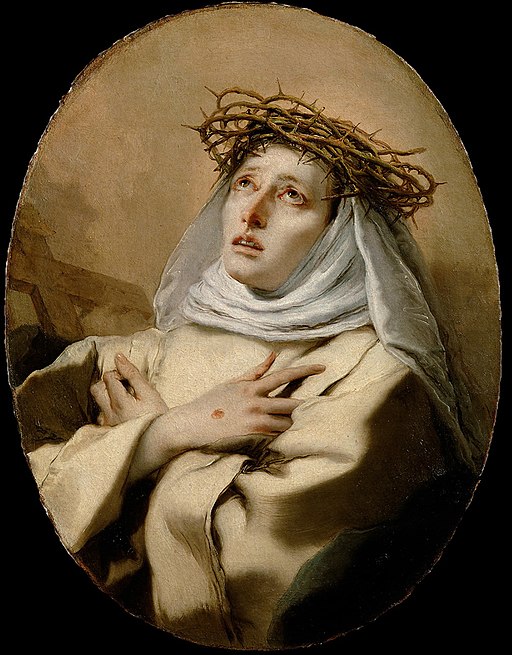
Giovanni Battista Tiepolo: English: St. Catherine of Siena
Artist
Giovanni Battista Tiepolo (1696–1770)
English: St. Catherine of Siena
Medium oil on canvas
Dimensions oval: 70 x 52 cm Rahmenmaße: 83,5 x 66,5 x 6,5 cm
Collection: Kunsthistorisches Museum Wien, Gemäldegalerie
Source/Photographer Kunsthistorisches Museum Wien, Bilddatenbank.
Ex wikipediacommons.
https://upload.wikimedia.org/wikipedia/commons/thumb/a/a0/Giovanni_Battista_Tiepolo_096.jpg/512px-Giovanni_Battista_Tiepolo_096.jpg
Short summary of Catherine of Siena. Ex wikipedia
https://en.wikipedia.org/wiki/Catherine_of_Siena
From Wikipedia, the free encyclopedia
Catherine of Siena
Catherine of Siena (25 March 1347 – 29 April 1380), a lay member of the Dominican Order, was a mystic, activist, and author who had a great influence on Italian literature and the Catholic Church. Canonized in 1461, she is also a Doctor of the Church.
She was born and raised in Siena, and at an early age wanted to devote herself to God, against the will of her parents. She joined the "mantellate," a group of pious women, primarily widows, informally devoted to Dominican spirituality. Her influence with Pope Gregory XI played a role in his decision to leave Avignon for Rome. She was then sent by him to negotiate peace with Florence. After Gregory XI's death and peace was concluded, she returned to Siena. She dictated to secretaries her set of spiritual treatises The Dialogue of Divine Providence. The Great Schism of the West led Catherine of Siena to go to Rome with the pope. She sent numerous letters to princes and cardinals to promote obedience to Pope Urban VI and defend what she calls the "vessel of the Church." She died on 29 April 1380, exhausted by her rigorous fasting. Urban VI celebrated her funeral and burial in the Basilica of Santa Maria sopra Minerva in Rome.
With a retinue about her constantly changing, the fasting can never be proven to have been rigorous or continuous but her eventual death by a wasting body implies a less than adequate diet at some periods of her life.
Canonisation of Catherine , article on a website blog with pictures.
https://idlespeculations-terryprest.blogspot.com/2006/11/st-catherine-of-siena-canonisation.html

Canonisation of Catherine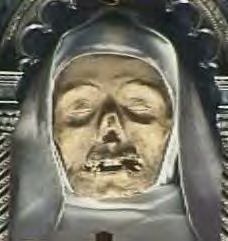
The St Catherine Head preserved in Siena Cathedral.
Head picture.
The phenomenon of Anorexia Mirabilis had started.
The next notable one being Lidwina of Schiedam, and our speaker then took us thought many other fasting girls including those in the British Isles, one in Wales and one in Culcheth.
Wales.
Welsh fasting girl Sarah Jacob.
Her tale leads to many interpretations partly of religious and partly of potential fraud (was she a ‘night eater’ in the dairy and kitchen area of her house) and the ultimate trial of her parents for not feeding her.
The speaker has diagrams of the house with attached milking shed which showed how easy it was to move from bed to a food store.
He intergrated a moment of humour when a 'watcher' sent to determine if food was provided or taken during night hours proved to be a local drunk.
The story is summarised in a Wikipedia article.
https://en.wikipedia.org/wiki/Sarah_Jacob
Biography ex link: https://www.wikizero.com/en/Sarah_Jacob
Sarah Jacob was born at Lletherneaudd, near Pencader, Carmarthenshire, the daughter of a farmer. Among her family, she was known by the pet name "Sal". From the age of ten, she was said to have gone without food for long periods but without any apparent effect on her health. Her parents began to receive visitors and to display the child to them, claiming that she had not eaten for many months; by the time she died, she was said to have gone without food for a total of 113 weeks. When the news of her supposed fasting reached the national press, an article on the subject was published in The Lancet, and eventually a team of four nurses was sent to the house to observe her and see whether she was secretly eating and drinking. They began their observations on 9 December 1869, and the girl died just over a week later. During the period the nurses were present, no one attempted to feed her. An autopsy performed after her death found generally healthy anatomy and fat tissue, as well as faeces low in her intestines, indicating that she had been consuming food up until the start of the last observation period.
Trial of her parents.
http://www.welshlegalhistory.org/research-jacob-trial-report.php
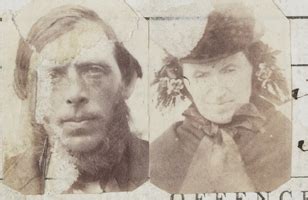
Sarah Jacobs parents
Welsh Legal History Society.
Cymdeithas Hanes Cyfraith Cymru.
This website of historical Welsh Legal History illustrates the measures of the day and its widespread reporting. The trial found her parents had failed in the duty to keep her alive, and their religious sworn oath that they would not feed her unless she deliberately asked for food was found to be a lesser duty than the legal duty of parents to support their offspring. Their legal duty came above their religious beliefs.
Quote from a local newspaper.
The report from the Tivy-side Advertiser, July 15th 1870, of the trial of Evan and Hannah Jacob, the parents of Sarah Jacob, at the Carmarthenshire assizes.
Trial of the parents of the welsh fasting girl for manslaughter.
These Assizes were opened in Carmarthen on Tuesday evening last, before the Hon. Sir James Hannen, Knight. There were but few cases entered for hearing, and the whole interest and excitement of the assize naturally centred in the trial of Evan and Hannah Jacob, the parents of the Welsh Fasting Girl. The following brief recapitulation of the facts of this remarkable case may perhaps be not uninteresting to our readers.
“Mr. Michael, on the part of the female prisoner, submitted that the indictment against Mrs. Jacob could not be sustained, as there was no duty on the part of the mother to supply food to the child while the father was living.
Mr. Giffard said it was not a question of duty to supply food, but wilful refusal to exercise that duty.”
This site shown below allows you to view the court records easily:
https://viewer.library.wales/4631929#?c=&m=&s=&cv=16&manifest=https%3A%2F%2Fdamsssl.llgc.org.uk%2Fiiif%2F2.0%2F4631929%2Fmanifest.json&xywh=-1653%2C-1%2C9082%2C7375
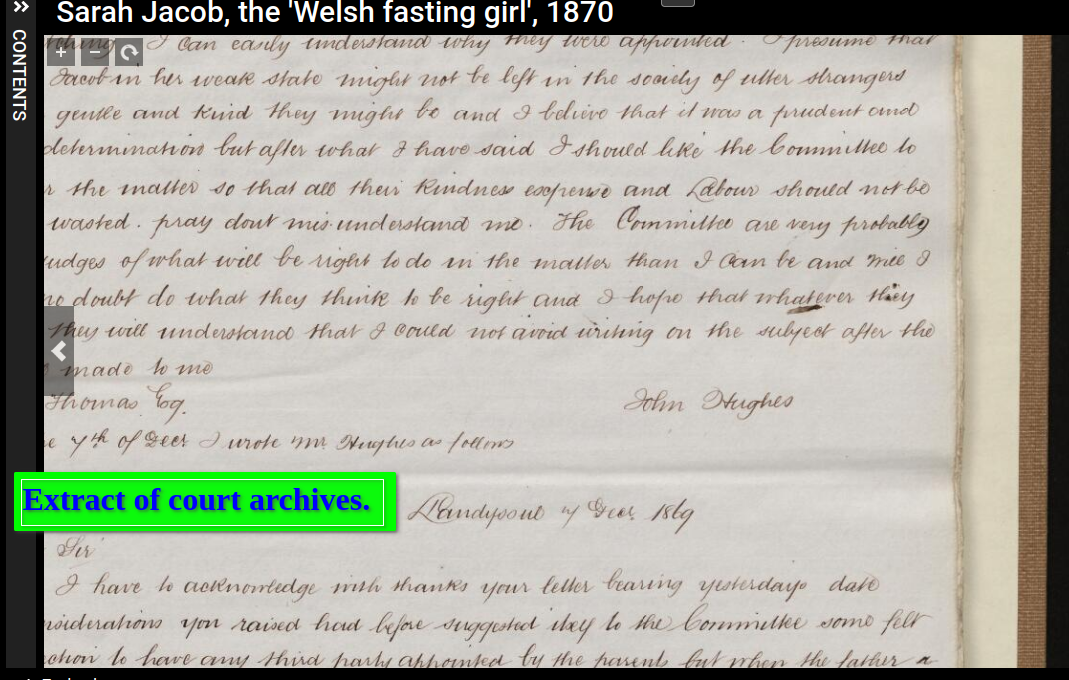
Evidence of eating was given in the post mortem examination report.
There was also the evidence from the post mortem of some food being taken during the supposed months of fasting .
A) Now available at link
The Lancet, Volume 96, Issue 2448, 30 July 1870, Pages 150-152 [NOTE: PDF is behind an expensive paywall.]
https://www.sciencedirect.com/science/article/abs/pii/S0140673602615016
“Remarks in reference to the presence of fat and absence of attenuation of the intestines in the body of Sarah Jacob, the "welsh fasting girl."
B) There is also a full PDF of the medical evidence available from the BMJ
“A Continuance of the Case of the Welsh Fasting Girl
With an Account of the Post Mortem Appearances, by Thomas Lewis; Copyright BMJ.
Link:
https://www.ncbi.nlm.nih.gov/pmc/articles/PMC2259906/pdf/brmedj05438-0003b.pdf
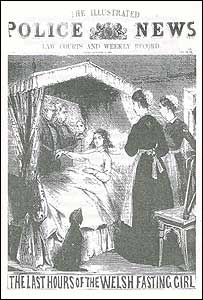
The popular press has a field day with this story.
Parents sent to trial.
Defence Brief.
The brief for the defence is available in the Welsh National Library
“Brief for the defence in the case heard at the Carmarthenshire Assizes, July 1870, against Evan and
Hannah Jacob of Llanfihangel-ar-arth, co. Carmarthen, for the manslaughter of their daughter, Sarah
Jacob (1857-69), the 'Welsh Fasting Girl'; the brief includes transcripts of depositions by witnesses, taken before the magistrates at Llandysul, and of related correspondence.”
Link: https://archives.library.wales/downloads/sarah-jacob-welsh-fasting-girl.pdf
Trial result.
In July 1870, Sarah's parents, Evan and Hannah Jacob, were brought to trial at Carmarthenshire Assizes, accused of manslaughter. They were monoglot Welsh speakers, and the court proceedings had to be translated for them. They pleaded not guilty, but were convicted and received prison sentences.
An alternative Welsh Library website for linked papers with pictures of the archival documents.
Handwritten attestation, reports and trail observations
Attribution: Llyfrgell Genedlaethol Cymru –
This site allows you to view the court records easily:
https://viewer.library.wales/4631929#?c=&m=&s=&cv=16&manifest=https%3A%2F%2Fdamsssl.llgc.org.uk%2Fiiif%2F2.0%2F4631929%2Fmanifest.json&xywh=-1653%2C-1%2C9082%2C7375
The handwritten documents are in English, and with a magnifying glass readable in a browser; OR
by clicking inside the picture of the document page it is enlarged.
Modern thoughts. Perhaps some modern problems with the trial.
All of the above to modern persons indicates a total absence of consideration of the parent’s then actual relationship with their religion and language and culture, by the trial process:
The parents were monoglot Welsh speakers.
All proceedings were in English under English law..
The court discounted their extreme consideration that a religious duty and swore oath in their culture were higher than the ‘Foreign Language
Law’ under which they were tried.
The mother using the consideration that she had no duty as long as a male (the father) was the household head.
Modern thoughts on avoiding extreme drudgery.
Was the girl using her illness to dodge the hard work on the family farm, which would be normal for offspring at their time, with connivance from her sister? Did the dodge became a way of life?
Mollie Fancher
The speaker then referenced and illustrated the “Brooklyn Fasting Girl”
How the incidents were multiplied by the press, and thus visitors and others became interested and the thing became a USA national incident.
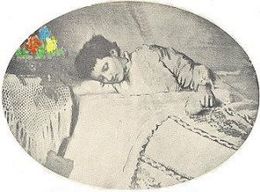
Mollie Fancher in bed
Mary J. "Mollie" Fancher (August 16, 1848 – February, 1916), otherwise known as the "Brooklyn Enigma", was extremely well known for her claim of not eating or eating very little for extended periods of time. She attended a reputable school and, by all reports, was an excellent student. At age 16, she was diagnosed with dyspepsia. At around the age of 19, reports came out that she had abstained from eating for seven weeks.
It was after two accidents, in 1864 and 1865, that she became famous for her ability to abstain from food. As a result of the accidents, Mollie Fancher lost her ability to see, touch, taste, and smell. She claimed to have powers that involved her being able to predict events as well as to read without the ability of sight.
By the late 1870s, she was claiming to eat little or nothing at all for many months. Her claim to abstinence from food lasted for 14 years. Doctors and people in the public began to question her abilities and wished to perform tests to determine the truthfulness of her claims. The claims to abstinence were never verified and she died in February 1916.
The events and her life have generated a lot of books, websites and articles.
The speaker then returned to more local events in the UK.
Tutbury. Ann Moore
Ann Moore (31 October 1761 – 1813) was an English woman who became notorious as the fasting-woman of Tutbury. From 1807 to 1813, she claimed to have eaten nothing at all, but her claims were eventually shown to be a hoax.
Refer: https://en.wikipedia.org/wiki/Ann_Moore_(impostor)
The conclusion in the Wikipedia article was:
Some modern historians view her actions as an early form of social protest, while others view it as simple fraud.
Extract from report.
In the summer of 1812, Alexander Henderson (1780–1863) Physician to the Westminster General Dispensary, wrote an able Examination of the imposture, showing the inconsistencies and absurdities of the woman's statements, and the curious parallel between the case and that of Anna M. Kinker, a girl of Osnabrück, who practised a similar imposture in Germany in 1800. Henderson reported that Ann claimed to have not eaten solid food for "upwards of five years" and had not drunk liquid for four years. She claimed that she did not pass urine or any other matter.
The watch over the girl.
In 1813, Ann reluctantly agreed to another watch, [EDIT: over her feeding] this time supervised by local writer and clergyman Legh Richmond. She was reportedly reluctant to participate, and particularly objected to the regular weigh-ins. The watch began on 21 April 1813, by 30 April 1813, Moore was visibly emaciated and feverish, and her daughter was forced to stop the study.
Further investigation of Moore's bedsheets showed evidence of excreta and fluids. She initially stood by her story, but later recanted. Evidence suggested her daughter had been smuggling in food via various means, including by putting a towel soaked with broth over her mother's mouth and conveyed food from her mouth to her mother's while kissing her.
She died a few months afterwards, aged 53 years.
Modern thoughts.
Some modern historians view her actions as an early form of social protest, while others view it as simple fraud.
Lancashire.
Then our speaker told of local village events in Lancashire and Culcheth.
A Culcheth doctor and a fasting girl made the news throughout the UK.
The tale of this local fasting girl Sarah Sudworth and the local doctor writing to The British Medical Journal to avoid any change of criminality by neglect of duty made the news in England, perhaps he doctor wrote to avoid any suspicion of his neglect of patents that might lead to charges as in the Welsh fasting girl case.
For the events see
https://thebeetonideal.co.uk/2017/06/13/the-case-of-the-fasting-girl-genuine-hysteria-or-fraud/
On January 4th 1870, Dr. R. Sephton left his house in Culcheth, travelling about a mile to the house of the Sudworths to treat their daughter, Ellen. Dr Sephton attended to his young patient, finding she had developed a fever. He diagnosed Ellen with febricula and debility and saw her a few more times over the next couple of months while he administered treatment. By March, Ellen had fully recovered, to the relief of her family. However, this relief was short-lived since they noticed that Ellen had developed a severe case of melancholia, which showed no signs of dissipating. A year later, in June 1871, the family called Dr Sephton to once again attend to their daughter who was suffering with headaches; six weeks later she had completely lost her voice. Ellen spent the next five years in a state of catatonia, sleeping frequently and keeping nourished only with soups and milk-puddings. Late in the year of 1875, Ellen developed additional symptoms: she could not open her eyes and blood poured from her eyelids and mouth. Six weeks later, Ellen suddenly sat up and began to speak, for the first time in nearly five years.
The report on this case is told by Dr Sephton in the 11 March issue of the British Medical Journal, titled ‘The Fasting Girl in Lancashire.’ Following the retelling of the above story, Sephton offers his diagnosis, which had remained unchanged through the past five years. Ellen Sudworth, claims Dr Sephton, has had a clear-cut case of hysteria.
Refer the 11 March 1876 issue of the British Medical Journal, titled ‘The Fasting Girl in Lancashire.’
Where there is an image of the report.
Refer: https://www.bmj.com/content/1/793/328
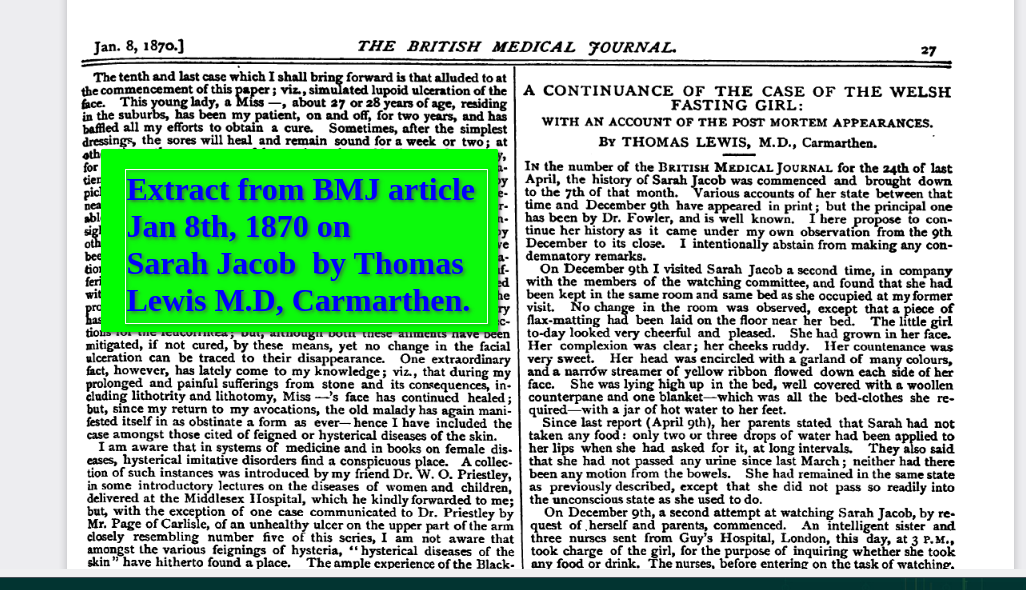
The speaker outlined how out of these and similar cases came the terms “Anorexia Nervosa”, and “Anorexia Mirabilis”,
and a study of refusal of food which today might include the cases of Buimia nervosa due to concieved bad body image.
Anorexia mirabilis,
Anorexia mirabilis, also known as holy anorexia or inedia prodigiosa or colloquially as fasting girls is an eating disorder, similar to that of anorexia nervosa.
https://en.wikipedia.org/wiki/Anorexia_mirabilis
Inedia.
Other linked events in Asia have been called in India & other places ”Inedia”
Inedia (Latin for 'fasting') or breatharianism is the claimed ability for a person to live without consuming food, and in some cases water.
Quote
Breatharians claim that food (and sometimes water) is not necessary for survival, and that humans can be sustained solely by prana, the vital life force in Hinduism. According to Ayurveda, sunlight is one of the main sources of prana, and some practitioners believe that it is possible for a person to survive on sunlight alone. The terms breatharianism or inedia may also be used when it is practised as a lifestyle in place of a usual diet.
Unquote
See note below on a 1999 UK occurance.
The audience were enthralled at this vivid talk about events which happened in the past but were not in our current knowledge.
Thanks.
Our group give our heartfelt thanks to Brian Joyce for his research and bringing together these events as a talk.
A "recent" related death in the UK.
1999 Scottish case (Belief of ability to survive without food)
http://news.bbc.co.uk/1/hi/scotland/453661.stm
Quote
Survival method. Ms Linn's writing's revealed she had practised "breatharianism" - a survival method which relies on light and taking only tiny amounts of food and liquid.
Police believe a woman found dead in a remote part of the Scottish Highlands may have starved herself as part of her religious beliefs. A diary belonging to Australian-born Verity Linn suggested she had been fasting to fulfill the rules of a ritual normally practised by Tibetan monks.
Her naked body was found on 16 September by a fisherman on the west coast of Sutherland near Loch Cam. It is understood Ms Linn - thought to be in her 40s - worked for the new-age community of the Findhorn Foundation at Cluny Hill College in Forres.
Her diary recorded her last days as she refused to eat or drink, believing it would "spiritually cleanse" her body and "recharge her both physically and mentally."
References.
List of references to these events and others for your perusal.
Anorexia nervosa
https://en.wikipedia.org/wiki/Anorexia_nervosa
Catherine of Siena
https://en.wikipedia.org/wiki/Catherine_of_Siena
Canonisation of St Catherine article link. Picture of head.
https://idlespeculations-terryprest.blogspot.com/2006/11/st-catherine-of-siena-canonisation.html
Lidwina of Schiedam
https://en.wikipedia.org/wiki/Lidwina
Multiple Sclerosis
https://en.wikipedia.org/wiki/Multiple_sclerosis
Lives of Catholic Saints Bollandist
https://en.wikipedia.org/wiki/Bollandist
Fasting Girl
https://en.wikipedia.org/wiki/Fasting_girl
Welsh fasting girl Sarah Jacob
https://en.wikipedia.org/wiki/Sarah_Jacob
Trial of Sarah Jacob’s parents
http://www.welshlegalhistory.org/research-jacob-trial-report.php
Presence of fat in intestines of Welsh fasting Girl at post mortem examination.
link (Behind a Paywall)
https://www.sciencedirect.com/science/article/abs/pii/S0140673602615016
Biography.
https://www.wikizero.com/en/Sarah_Jacob
Odd reference
Eugene Taylor, The Mystery of Personality, A History of Psychodynamic Theories
https://epdf.pub/the-mystery-of-personality-a-history-of-psychodynamic-theories-library-of-the-hi.html
Mollie Fancher–The Brooklyn Enigma .
(Brief story of Mollie Francher)
https://www.lightforcenetwork.com/glorious-bastard/mollie
Anorexia Mirabilis,
https://en.wikipedia.org/wiki/Anorexia_mirabilis
Writer's comments.
Comment on Medieval fasting.
What is a fasting girl?
Fasting Girls were girls or women in the Middle Ages who were said to eat little or nothing and yet live. These girls were also sometimes said not to defecate or sweat or menstruate. This was thought of as miraculous as well as curious, and these women and girls drew a lot of attention from regular people and the church. People came to see them, give them money, learn what God had revealed to them (if anything), and basically treated them as if they were holy, if curious, persons.
http://historyfish.org/anchorites/what_are_fasting_girls.html
Important note about avoiding enforced marriages of the time.
Quote
Some of these fasting women sought to escape marriage, or were dealing with other issues of suffering in their lives that seemed to manifest in extreme behaviours. Perhaps their often extreme focus on receiving the Eucharist as an actual (and only) meal came from some inner compulsion to deal with the troubles of their lives. Regardless, these women were both feared and admired.
Unquote
